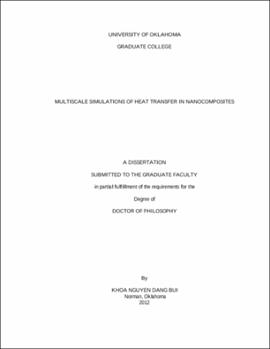| dc.contributor.advisor | Papavassiliou, Dimitrios V | |
| dc.creator | Bui, Khoa Nguyen Dang | |
| dc.date.accessioned | 2019-04-27T21:32:58Z | |
| dc.date.available | 2019-04-27T21:32:58Z | |
| dc.date.issued | 2012 | |
| dc.identifier | 99289979702042 | |
| dc.identifier.uri | https://hdl.handle.net/11244/318971 | |
| dc.description.abstract | The field of nanotechnology has been expanded by the discovery of fullerenes and carbon nanotubes (CNTs) in the 20th century. Geim and Novoselov won the Nobel prize in 2010 for their work on graphene sheets (GSs). Those materials with their outstanding properties have been suggested as reinforcement fillers in a variety of composite materials. By incorporating these nanomaterials into a polymer matrix, or dispersing them into a solution, the effective thermal conductivity of the resulting composite (Keff) can be increased. For example, this enhancement can range from 80% to 125% at 1.0wt% of CNTs over pure polymer for the case of epoxy composites or by a factor of almost 4 in the case of high concentration of single-walled carbon nanotubes (SWNTs) in poly-styrene. However, based on the properties of pristine CNTs and GSs, one would expect a much higher value of Keff of such composites, more than one order of magnitude according to the classical theory of Maxwell. The presence of resistance to heat transfer at the nanoinclusion-polymer interface, known as the interfacial thermal resistance or Kapitza resistance, is the reason for this difference. | |
| dc.description.abstract | Experimentally measuring and characterizing heat transport at the nanoscale are not trivial tasks and current theory in this area is limited to simple cases only. The acoustic mismatch theory and the effective medium theory provide a rough estimation of Kapitza resistance and Keff of the composites, respectively. However, the effect of dispersion pattern and the orientation of nanoinclusions inside the polymer matrix on Keff is still an open question. For the case of multi-walled carbon nanotubes (MWCNTs) embedded in polymer matrix, it is unknown whether thermal transfer occurs solely via the outermost wall or through the center of the tube. | |
| dc.description.abstract | In this work, Monte Carlo (MC) simulations were developed to investigate heat transfer in nanocomposites. This approach is capable of taking into account the effect of different geometries, realistic orientations, and dispersion patterns of nanoinclusions on Keff. Furthermore, molecular dynamics (MD) simulations were employed coherently with MC simulations to characterize interfacial thermal resistance. Results from this work provide suggestions for producing superior thermal nanocomposites through the controll of Kapitza resistance and the configurations of nanoinclusions inside the polymer matrix. | |
| dc.format.extent | 124 pages | |
| dc.format.medium | application.pdf | |
| dc.language | en_US | |
| dc.relation.requires | Adobe Acrobat Reader | |
| dc.subject | Nanotechnology | |
| dc.subject | Heat--Transmission | |
| dc.subject | Energy transfer | |
| dc.subject | Nanocomposites (Materials) | |
| dc.title | MULTISCALE SIMULATIONS OF HEAT TRANSFER IN NANOCOMPOSITES | |
| dc.type | text | |
| dc.type | document | |
| dc.thesis.degree | Ph.D. | |
| ou.group | College of Engineering::School of Chemical, Biological and Materials Engineering | |
